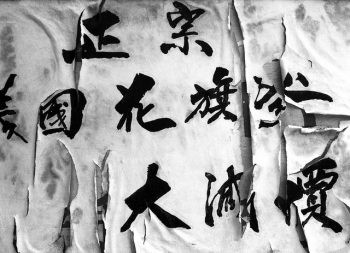Xu Bing: An Introduction Posted by Ayana on Mar 6, 2017 in Uncategorized
Xu Bing is a Chinese artist who has been creating works of wonder, blending Chinese traditions with contemporary art. The complex relationship between language (语言Yǔyán) and meaning has been a central preoccupation of his art. For over 40 years, he has attempted to discover Chinese culture (文化Wénhuà) through calligraphy. He is fascinated by the way meaning is been created in our words (词Cí), and explores not only the content of the words, but also their packaging.
Xu Bing (徐冰Xú bīng) was born in 1955, to parents who were both working at Beijing University (大学Dàxué). His mother was a librarian, his father was a historian, but Xu Bing – who was surrounded by books (书Shū) as a child – preferred painting. During the cultural revolution, the Xu family was torn apart. The father was imprisoned and Xu Bing, as many other young intellectuals, was sent to the countryside. He was sent to a remote village north of Beijing and worked hard on the fields with the peasants.
Talented Xu Bing was lucky enough to graduate high school (中学Zhōngxué) before being sent to do labor in the north. His calligraphy and typography skills were his saving grace. He threw himself into propaganda projects, wrote political banners and posters, and in return was allowed to continue his education (教育Jiàoyù). Under chairman Mao’s regime, the Chinese nation reformed and the Chinese language (中文Zhōngwén) followed suit. The characters had been simplified, and the language became a tool for propaganda. Young Xu Bing saw the process of writing become a means of conveying Communist messages.
When the revolution ended in 1976, Xu Bing entered the printmaking department of Central Academy of Fine Art in Beijing. His first work, after he graduated (毕业Bìyè) with masters, was The Book from the Sky. For more than four years, Xu Bing worked on this installation: printed volumes and scrolls filling the room from floor to roof. Hand bound open books on the floor resemble the sea; long paper-scroll hanging from the ceiling resemble the sky; and many documents on the walls resemble the landscape. All of them filled with thousands of meaningless Chinese characters (汉字Hànzì). Xu Bing designed and crafted more than 4,000 characters from scratch. At his youth, propaganda banners of Chinese characters delivering political thoughts encircled Xu Bing. Over a decade later, Xu Bing used the Chinese script to deliver an artistic message. After witnessing the way language can be twisted to one’s needs, Xu Bing twisted the Chinese script in the name of art. He used invented characters to depict a Chinese painting.
Watch this short but profound video on this installation, in the Metropolitan Museum of Art:
Twenty years later, Xu Bing published an actual book: a hard-cover book named The Book from the Ground. Despite his attraction to calligraphy (书法Shūfǎ), Xu Bing’s book has zero Chinese characters inside it. It’s a graphical novel (小说Xiǎoshuō) – an account of twenty-four hours in the life of a typical urban man – composed entirely of symbols and icons. While The Book from the Sky was composed of illegible Chinese characters that no one could read, The Book from the Ground is a book that anyone can read.
Watch this episode of ‘Brilliant Ideas’ on Xu Bing, his works and book:
Visit Xu Bing’s website:
http://www.xubing.com/
Text vocabulary
Culture = 文化Wénhuà
Chinese culture = 中国文化 Zhōngguó wénhuà
Language = 语言Yǔyán
Chinese language =中文Zhōngwén
Word, words =词Cí
Book, books = 书Shū
Education = 教育Jiàoyù
University = 大学Dàxué
High school = 中学Zhōngxué
To graduate = 毕业Bìyè
Chinese character, Chinese characters = 汉字Hànzì
Calligraphy = 书法Shūfǎ
Novel = 小说Xiǎoshuō

Build vocabulary, practice pronunciation, and more with Transparent Language Online. Available anytime, anywhere, on any device.





Leave a comment: